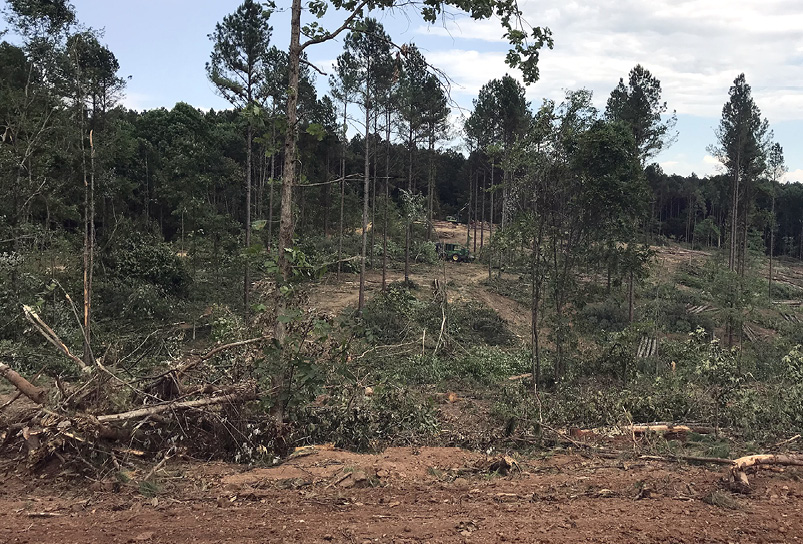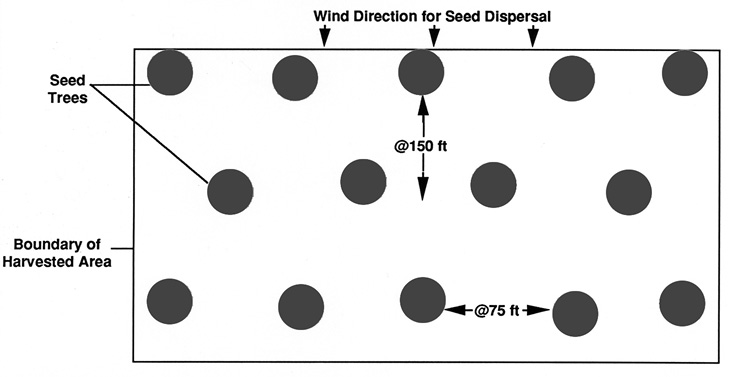Natural Regeneration Using Seed Trees

Over the past few decades, the forestry field has moved away from the traditional “cut and walk away” approach to regeneration; however, one of the most serious forest management problems in Mississippi is still a lack of proper regeneration. This is especially true on nonindustrial, private forestland. Unless a stand of desirable crop trees is regenerated on these lands, all the intermediate management available is relatively useless. All forestry endeavors either start with or eventually end up at the regeneration stage, but many landowners do not realize that several options are available and that often regeneration work should start long before harvest of the current crop of trees.
Reasons for not regenerating are varied and, for the most part, not ecologically or economically savvy. One of the most common reasons is the belief that trees will regenerate themselves with no managerial input. This is true, but we have little control over what species regenerate or how long the process takes in this scenario.
Another major concern in regeneration is cost. While money is a valid consideration, it should not be prohibitive because many regeneration options are available. Often, when landowners learn the per-acre cost of site preparation, seedlings, and planting can be $100 to $200 for pines and $200 to $500 for hardwoods, many of them immediately stop considering any regeneration work. Does regeneration have to cost so much? The answer is “no,” but alternatives to high-cost systems require careful planning and effort from the forest manager or landowner before harvest. Typically, if no provisions are made for regeneration prior to timber being cut, the amount of effort, money, and time needed to reestablish the stand increases dramatically.
The landowner may have alternatives for regeneration. These alternatives will be determined by these factors:
- what is occupying the site currently
- what is desired on the site
- when regeneration efforts will begin
The key to regeneration is to manage your stands so that you have alternatives, then use the most cost-effective system to obtain the desired crop.
Seed-Tree Regeneration
The seed-tree system is a harvest/regeneration activity in which an appropriate number of individual trees is left across an area to provide seed for production of the next crop of trees. While there is no provision for improving genetics above what is already present on-site, the method is a good choice for naturally regenerating shade-intolerant species like the southern pines. Interest in naturally regenerating pines has decreased in the last few decades due to the improved genetics available in current seedling stock; however, due to decreased demand and stumpage prices for pine sawtimber, seed-tree regeneration is once again becoming a regeneration method of interest.
It is important to evaluate stands to determine whether or not seed-tree cutting is possible. If you have the desired species of adequate quality and you manage them properly, seed-tree cutting can provide satisfactory results on most properties. Research has shown that seed-tree cutting does not improve desirable hardwood regeneration in most situations.
Preharvest Activities
For seed-tree cutting to be successful, you must control undesirable vegetation to allow establishment of desirable seedlings. This work usually starts 4 to 5 years before harvest, with annual or biannual prescribed burns in pine stands that will give some control of undesirable species and prepare the seedbed. It is important to remember that most light-seeded species require exposed mineral soil for proper germination and seedling establishment.
Injection or other timber stand improvement (TSI) methods should be used on larger stems that cannot be controlled with burning unless they are to be sold in the harvest. For more detailed information regarding stem injection and TSI, please read MSU Extension Publications 2942 Tree Injection for Timber Stand Improvement and 1281 Timber Stand Improvement. When preharvest preparation activities are complete, trees to be left for seed production can be marked.
Desirable Seed Trees
When marking a seed-tree cut, the goal is to leave the absolute best trees of the desired species. The following characteristics are desirable for all seed trees: tall, straight, well-pruned, well-developed crown, average seed production, disease-free, superior volume growth, and have wind-disseminated seeds. Volume production is extremely important for commercial forestry, so most species appropriate for this method develop in even-aged stands or even-aged groups. Consequently, trees can be compared to others in the immediate area to evaluate their total growth and development.
The best trees must be left because poor regeneration may be obtained if poor quality seed stock make up the residual stand. If you cannot leave these “superior” trees, use another form of regeneration to start the next forest. With proper management and careful thinning during the next rotation, seed-tree cutting should be a viable option when regeneration is next required.
How Many Trees to Leave?
The number of required leave trees is a function of the following:
- desired amount of regeneration
- seed production by individual tree
- expected seed survival
- height of trees
- projected tree mortality (loss)
Critical Facts
Average number of cones per bushel (can count conelets to estimate seed production for the following year):
- Loblolly = 35
- Longleaf = 25
- Shortleaf = 40
- Slash = 30
Average number of seeds per bushel of cones:
- Loblolly = 18,000
- Longleaf = 4,000
- Shortleaf = 34,000
- Slash = 9,500
Seed survival:
1 to 3 percent of sound seed should produce seedlings (varies due to site, seed, drought, insects, and predation)
Seed distribution:
On average, loblolly pines will reliably distribute seeds a distance of twice the tree’s height. Shortleaf seeds will travel farther, while slash and longleaf will not travel as far.
Example
How many loblolly pines should be left to regenerate an area if seed production is expected to be one bushel per tree and average tree height is 75 feet?
- Number of seedlings desired = 2,000 to 3,000/acre
- Number of seed produced/tree = 18,000
- Expected seed survival = 2 percent
- Seedlings produced per tree = 18,000 x 0.02 = 360
- Number of trees required = 2,000 ÷ 360 = 6 trees/acre*
- Height requirement = no restriction
*You may want to leave an extra two to four trees per acre as insurance against potential loss (windthrow, bark beetles) or seed-crop reduction.
Distribution of Trees
Select and mark trees with adequate distribution to provide seeds fully across the entire area. The direction of the prevailing wind at the time of seed fall dictates distribution and location of seed trees.
Trees should be left along the harvest boundary on the side from which prevailing winds will come. If the adjacent stand of trees is deemed to be of acceptable quality, you can expect seeds to blow into the regeneration area from that source. Conversely, no trees are needed on the edge opposite the direction of prevailing winds.
Perhaps the easiest way to ensure proper seed-tree distribution is to consider leaving trees in terms of rows that run perpendicular to the prevailing wind. For loblolly pine, these rows can be spaced approximately two times the height of the trees themselves. For example, if the average height of the seed trees is 75 feet, the rows of leave trees could be about 150 feet apart (Figure 1). In terms of positions within rows, seed trees are typically spaced a distance apart that is equal to the average height of the trees. So, in the example of 75-foot trees, the distance between trees within rows would be 75 feet.

Use with Hardwoods
A basic premise of seed-tree operations is that the seed will be spread across the harvested area by wind. For this to work, the species must be light-seeded (Figure 2).
Most light-seeded hardwoods are not desirable for timber management, but this method could be used for a few (e.g., sweetgum, yellow poplar, green ash, cottonwood, and sycamore); however, most currently desirable hardwood species for timber production are heavy-seeded.
Species such as oak and black walnut have seeds far too heavy to be spread by wind. For this reason, seed-tree harvesting is not a good choice for regenerating most desirable southern hardwood species.

Postharvest Activities
After harvest activities are completed, another prescribed burn will help reduce debris and make final preparation of the seedbed. It is important to note that this burning should be before seed fall, which typically occurs in late October or November in Mississippi.
Evaluate seed-tree areas during the winter following the first growing season after harvest. This work is more accurate and efficient in the winter. Tiny, green pine seedlings will contrast against the dormant, brown vegetation on the area (Figure 3). In addition, it is easier to move across the site in winter.
As soon as adequate density and stocking of regeneration is achieved, remove seed trees. If they are not removed, they will have a negative impact on development of established regeneration. Further, they will continue to disseminate seeds across the area, and that can cause an overstocking of seedlings.
With current market conditions, it is increasingly hard to sell small volumes of sawtimber. This often makes it difficult to market seed trees. If you cannot find a logger willing to remove them, cutting them in place will promote continued development of the new crop of seedlings.
If adequate regeneration has not been achieved after 2 years, you will need to burn the site to control undesirable vegetation and prepare a new seedbed (Figure 4). This could happen if your planned regeneration year is extremely droughty or if an unexpected flood washes seeds away from the area. This is not a typical occurrence.


The information given here is for educational purposes only. References to commercial products, trade names, or suppliers are made with the understanding that no endorsement is implied and that no discrimination against other products or suppliers is intended. This work is supported by the USDA National Institute of Food and Agriculture, Renewable Resources Extension Act Project No. MISZ069400, Accession No. 1002390.
Publication 1816 (POD-02-23)
Revised by A. Brady Self, PhD, Associate Extension Professor, Forestry; from an earlier edition by Andrew W. Ezell, PhD, Professor Emeritus, Forestry.
The Mississippi State University Extension Service is working to ensure all web content is accessible to all users. If you need assistance accessing any of our content, please email the webteam or call 662-325-2262.




